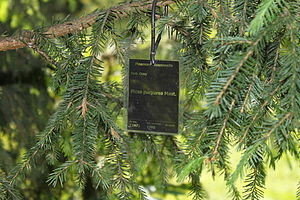Purple spruce
| Purple spruce | ||||||||||||
|---|---|---|---|---|---|---|---|---|---|---|---|---|

Purple spruce ( Picea purpurea ) |
||||||||||||
| Systematics | ||||||||||||
|
||||||||||||
| Scientific name | ||||||||||||
| Picea purpurea | ||||||||||||
| Mast. |
The purple spruce ( Picea purpurea ) is a species of the pine family (Pinaceae). It is native to central China .
description
The purple spruce grows as an evergreen tree that can reach stature heights of up to 50 meters and chest height diameters of up to 1 meter. The trunk ends in a pyramidal crown . The dark gray trunk bark is scaly. The bark of the branches has a thick hair, and is at first yellow or pale brown yellow, discolored with time but greyish to gray.
The resinous winter buds are conical in shape. The straight to slightly curved needles , keeled on both sides, are 0.7 to 1.2 inches long and between 0.15 and 0.18 inches wide. They have a broad, diamond-shaped cross-section and their tip is blunt to tapering to a point. On the underside of the needle there are four to six no stomatal lines , or sometimes one to two incomplete stomatal lines, on the upper side of the needle .
The purple spruce is single-sexed ( monoecious ) and the flowering time is in April. The cones are cylindrical-egg-shaped to egg-shaped with a length of 2.5 to 6 centimeters and a thickness of 1.7 to 3 centimeters. When they ripen in October, they are reddish-purple in color, through dark purple to black-purple. The paper-like seed scales are 1.3 to 1.6 centimeters long and around 1.3 centimeters wide and have a diamond-shaped, egg-shaped shape. Their edge is wavy and serrated irregularly. The seeds , together with the brown seed wing with purple dots, are around 0.9 centimeters long.
The number of chromosomes is 2n = 24.
Distribution and location
The natural range of the purple spruce is in central China. It includes southern Gansu , eastern Qinghai and northwestern Sichuan .
The purple spruce thrives at altitudes of 2600 to 3800 meters. It grows in mountains, especially on northern slopes, on gray-brown mountain soils or mostly podsolized lithosols . The climate is a cool continental climate with little rainfall, most of which falls as snow. The Picea purpurea forms monocultures or mixed stocks with other pine plants such as Abies Fargesii ( Abies fargesii ), Larix potaninii , the bristles spruce ( Picea asperata ), Wilson's spruce ( Picea wilsonii ) and lower layers, the Chinese hemlock ( Tsuga chinensis ). In the mixed stands there are also deciduous trees such as birch ( Betula ) and poplar ( Populus ) as well as oak ( Quercus ) at lower altitudes .
Hazard and protection
Picea purpurea is classified as "low endangered" in the IUCN Red List . The main hazard mentioned is logging along with the low rate of regeneration. The total population of the species is considered to be declining and has declined over the past hundred years. For this reason, the Chinese government has banned logging in sensitive areas.
use
The high-quality wood of the purple spruce is used. Its quality is similar to that of the Likiang spruce ( Picea likiangensis ).
Systematics
Picea purpurea is within the genus of spruce ( Picea the subgenus) Casicta , the section Sitchenses and serial Likiangenses assigned.
It was first described as Picea purpurea in 1906 by Maxwell Tylden Masters in Journal of the Linnean Society, Botany , Volume 37 (262), page 418.
swell
- Christopher J. Earle: Picea purpurea. In: The Gymnosperm Database. www.conifers.org, November 28, 2012, accessed November 16, 2013 .
- Liguo Fu, Nan Li, Thomas S. Elias & Robert R. Mill: Pinaceae . Picea. In: Wu Zhengyi, Peter H. Raven & Hong Deyuan (eds.): Flora of China . Cycadaceae through Fagaceae. Volume 4. Science Press and Missouri Botanical Garden Press, Beijing and St. Louis 1999, ISBN 0-915279-70-3 , Picea purpurea , pp. 30 (English, Picea purpurea - online - this printed work is online with the same text).
Individual evidence
- ↑ a b c d e Christopher J. Earle: Picea purpurea. In: The Gymnosperm Database. www.conifers.org, November 28, 2012, accessed November 16, 2013 .
- ↑ a b c d e f Liguo Fu, Nan Li, Thomas S. Elias & Robert R. Mill: Pinaceae . Picea. In: Wu Zhengyi, Peter H. Raven & Hong Deyuan (eds.): Flora of China . Cycadaceae through Fagaceae. Volume 4. Science Press and Missouri Botanical Garden Press, Beijing and St. Louis 1999, ISBN 0-915279-70-3 , Picea purpurea , pp. 30 (English, Picea purpurea - online - this printed work is online with the same text).
- ↑ a b Picea purpurea at Tropicos.org. Missouri Botanical Garden, St. Louis, accessed August 1, 2016.
- ↑ a b Picea purpurea in the endangered Red List species the IUCN 2013. Posted by: A. Farjon, 2010. Accessed November 16, 2013.
- ↑ Picea purpurea. In: The Plant List. www.theplantlist.org, accessed on November 16, 2013 .